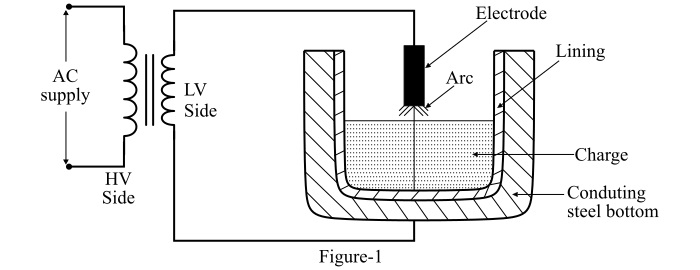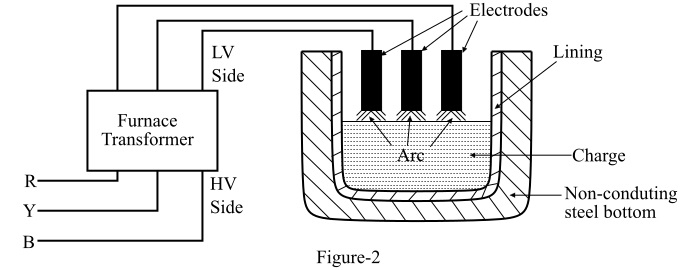
 Data Structure
Data Structure Networking
Networking RDBMS
RDBMS Operating System
Operating System Java
Java MS Excel
MS Excel iOS
iOS HTML
HTML CSS
CSS Android
Android Python
Python C Programming
C Programming C++
C++ C#
C# MongoDB
MongoDB MySQL
MySQL Javascript
Javascript PHP
PHP
- Selected Reading
- UPSC IAS Exams Notes
- Developer's Best Practices
- Questions and Answers
- Effective Resume Writing
- HR Interview Questions
- Computer Glossary
- Who is Who
Direct Arc Furnace: Types, Electrical and Mechanical Requirements
An electric furnace is the furnace that heats materials by means of an electric arc is called the electric arc furnace (EAF).
Direct Arc Furnace
The direct arc furnace is the one in which the electric arc is struck between the electrode and the charge, to be heated, so that the arc current flows through the charge and there is a direct contact between the arc and the charge.
In case of direct electric arc furnace, the heating process is faster and the heating efficiency is also high. In addition to the arc heating, some additional heat is produced by the passes of the electric current through the charge.
Types of Direct Arc Furnace
Electrically, the direct-arc furnaces can also be classified into two types, viz. Conducting Bottom Type and Non-conducting Bottom Type.
Conducting Bottom Type
Figure-1 shows the conducting bottom type direct-arc furnace. The conducting bottom type direct arc furnace has the bottom of the furnace as a part of the electric circuit.

Non-Conducting Bottom Type
The non-conducting bottom type direct arc furnace is shown in Figure-2. In this type of direct arc furnace, no current flows through the body of the furnace. In practice, most of the direct arc furnaces used are non-conducting bottom type due to insulation problems faced in the conducting bottom type furnaces.

Electrical Requirements of Direct-Arc Furnace
The fundamental electrical requirements of a direct electric arc furnace are as follows −
Supply to the electrodes
In case of direct arc furnace, the electrodes have to be short-circuited momentarily and then separated from the charge, to be heated, inside the furnace. It requires a low voltage on the secondary side. For this purpose, the furnace transformer has a high reactance and multiple tapings on the secondary side. The primary side has a line voltage of 11 kV while the secondary voltage varies between 350 to 400 volts. The change in the supply to the electrodes results in the temperature control of the charge.
Arc Stability
After striking the arc, the electrodes burn out gradually increasing the length of the arc. The arc will extinguish if the gap between the electrode and charge is not maintained properly. Also, the resistance of the metal undergoing heating increases gradually with the increase of temperature. These two factors considerably change the magnitude of the arc current and causes the unstable arc.
A current transformer (CT) is employed for transmitting the effect of change in current to an automatic regulator circuit, which adjust the height of the electrodes during the heating process, which increases the stability of the arc. The arc stability for a fixed gap between electrode and charge is further increased by high reactance of the furnace transformer.
Selection of Electrode Material
The electrodes used in direct arc furnace are made of either carbon or graphite. The graphite electrode is a refined and specially treated form of the carbon electrode and has four times conductivity. The carbon electrodes are cheap and have a current density of about 8 to 15 A/cm2 while for the graphite electrode, it is 32 to 60 A/cm2. Therefore, carbon electrodes are only suitable for low capacity direct arc furnaces.
Over Current Protection
With the exception of the momentary short circuit, the direct arc furnace is not supposed to draw an over-current, i.e., current greater than furnace rating, continuously. To achieve this, the current transformer (CT) operates an over-current protection relay, which trips the circuit breaker.
Isolation of Furnace from Supply
When the metal has to be charge into the furnace or melt or slag removed from the furnace, the furnace has to be isolated from the supply. For this, an isolator switch is used between the circuit breaker and the furnace transformer. Here, firstly the circuit breaker is switched off and then the isolator is opened. An isolator is also connected between the mains and the circuit breaker, for disconnecting the circuit breaker from the mains for maintenance.
Mechanical Requirements of Direct Arc Furnace
Shell Structure - The shell is made of steel and cylindrical in shape. It has two doors opposite each other for tapping (for melt removal) and slag removal. The roof is detachable otherwise, an extra door is to be provided for charging. It is desirable that the working furnace is air leak-proof to avoid the contamination of atmosphere from furnace fumes and hence provides controlled atmosphere heating facilities.
Lining Structure - The inner surface of the steel shell has to be lined with some heat resistant material which prevents the leakage of heat from the melt to the steel shell. The lining can be acidic or basic depending upon the nature of the melt and is different for different working temperature.
Charging - For charging of the furnace, the roof as a whole along with the electrode supporting column shifts to one side for the furnace of 3 tonne capacity or above. Then, the metal scrap is crane loaded into the furnace and hammered with the hanging loads. In case of small furnaces, the door charging is possible.
Removal of Melt and Slag - When the melt is ready, the door called tapping is opened and the furnace is tilted forward by 45° as a whole, throwing the melt into a ladle pit from where it is distributed for the specific operations. For the removal of slag, the furnace is tilted backward by 15° and the slag door is opened, and the slag is discharged into the slag pit.

